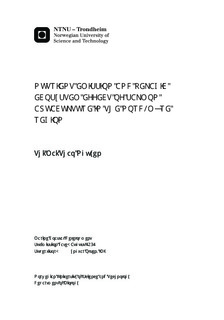NUTRIENT EMISSION AND PELAGIC ECOSYSTEM EFFECT OF SALMON AQUACULTURE IN THE NORD-MORE REGION
Master thesis
Permanent lenke
http://hdl.handle.net/11250/245208Utgivelsesdato
2012Metadata
Vis full innførselSamlinger
- Institutt for biologi [2596]
Sammendrag
The main objective of this thesis was to estimate nutrient emission rate of carbon (C), nitrogen (N) and phosphorous (P) waste from salmon farms and to evaluate the environmental impact of salmon aquaculture on planktonic ecosystems in the Nord-Møre region in the summer period from June to September in 2011. The 22 fish farms in the Nord-Møre region produced 37,114 tonnes wet weight (WW) of fish in the period. Emission rates of nutrient wastes were estimated for every month based on information about the use of feed and the mean food conversion rate of the feed in the county, together with measurable coefficients describing the elemental C, N and P composition of feed and fish and digestibility of C, N and P components of the feed. Of the total feed input, 64 % C, 59.2 % N and 75.2 % were released into the environment in the Nord Møre area, corresponding to 390 kg C, 38.7 kg N and 7.8 kg P per metric tonne WW of fish produced. We predicted that 42 % of feed C and 47 % of feed N were respired as CO2 and excreted as dissolved inorganic N (DIN), respectively, and 44 % of feed P was released as solid waste. Through the measurement, the results showed that there were no significant differences among nutrient concentrations and biological variables between sampling stations and respective reference stations. Therefore, we found that there was no effect from salmon fish farm activities in the Nord-Møre area in the summer period (Jun-Sep). Furthermore, with many fish farms surrounding the 2 sampling stations, we could expect the concentration of different nutrients and plankton biomass at sampling stations (PV1 & PV2) would be higher than those at respective reference stations (BA1 & BA2). However, the results showed that the concentration of different nutrients and plankton biomass at PV1 were lower than those at BA1 (except for particulate organic carbon concentration).
